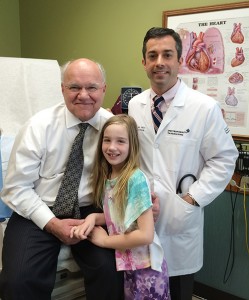
Instead of hitting the expressway as usual at the end of the day, attorney Frank Stanley circled the downtown Grand Rapids block. Again. And again.
“I went around that block about 10 times, on the phone with a nurse, deciding whether or not I should go to ER,” he recalled. “She was telling me to go. I was resisting.”
Stanley had been experiencing some odd symptoms for a couple months. A longtime runner, he’d let himself get out of shape.
“I hadn’t been able to run consistently and I was carrying extra weight,” he admitted. “My legs would feel heavy when I did run. And I was tired; that’s not like me.”
Vowing to get back on track, Stanley also faced an oppressive schedule in his legal practice, with a complex trial looming. He was so immersed in the demands of the case, it was easy to blame the increasing instances of pressure at the sternum on stress.
And, his cholesterol was OK, he’d never had heart problems and he’d controlled high blood pressure with medication for years. But that day while running, a searing pain had shot through his right arm that stopped him in his tracks.
He had to pause for a while before he could even make the trip back to the gym–at a slow walk. It was a couple more hours before the pain was gone.
“I was concerned over how long it took for the pain to subside, but then I felt OK again,” he said. “Plus, it was my right arm. I’d always heard it was the left for heart attack. So, I told myself, I could stop in to the ER, they would tell me I was stressed and I’d be home for dinner. I texted my wife that I couldn’t talk, but would call her when I was on the way home. That’s how sure I was.”
Instead, he called her two hours later to tell her that he was being admitted.
“The doctor looked at me and said, ‘You are a classic case of a person about to have a heart attack,” he said.
The next day, at the Spectrum Health Meijer Heart Center Catheterization Lab, cardiologist Ryan Madder, MD, performed a radial (wrist) cardiac catheterization. The radial entry is more complex than through the traditional groin artery, but offers benefits such as fewer post-procedure complications and faster recovery.
Dr. Madder found that all of the arteries to the heart were dangerously blocked. To assess the best approach to the secondary artery blockages, he called in a surgeon to talk it through. These weren’t ideal for stenting. Was it time for open heart bypass surgery?
Ultimately, Dr. Madder placed drug-eluting stents in the main “widow maker” and second major artery. The remaining blockages would be managed with medication. If symptoms could be controlled, Stanley could avoid open heart surgery. Time would tell.

“The staff and Dr. Madder were outstanding,” he said. “I could not believe how attentive and caring everyone was, from start to finish. We felt completely supported at every turn.”
Once home, the Stanleys had to adjust to many new medications and the unexpected fear they faced.
“I’m not afraid of anything, but found myself nervous about every twinge and sensation,” he said. “My wife was constantly watching me out of the corner of her eye and asking if I was OK.
“Fortunately, with the ability to get questions answered through Dr. Madder’s office, and gaining confidence that I really was feeling OK, I began to realize how fortunate I was.”
Today, Frank Stanley’s life is back to normal. He is more aware of the stresses of his law practice and tracks how he feels more closely. Annual follow-up with Dr. Madder, or an immediate call if symptoms reappear, are part of ensuring that any potential new blockages are caught early.
 /a>
/a>
 /a>
/a>
 /a>
/a>
Thank you for sharing your story. I am so glad to hear that you are doing well and your family and Spectrum Health professionals were there for your needs and continued care!